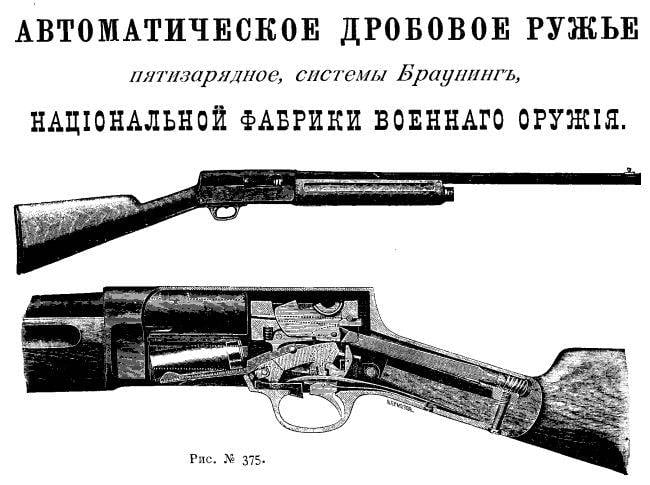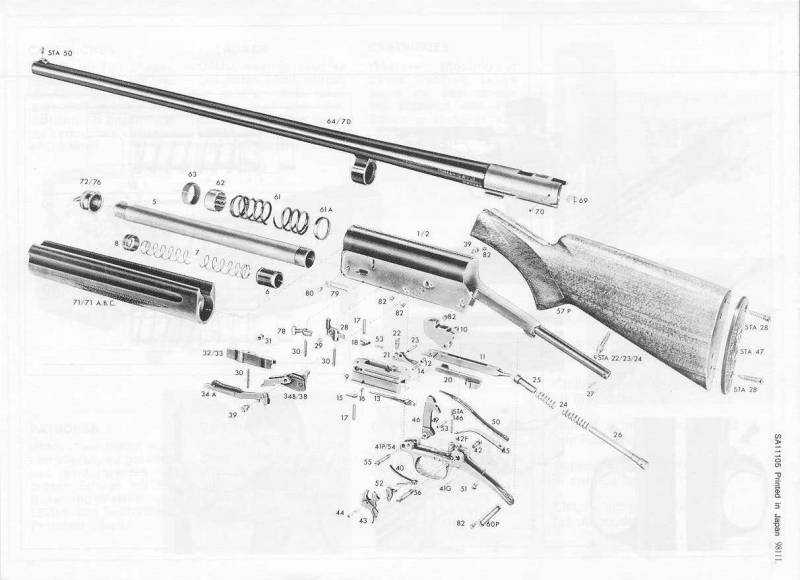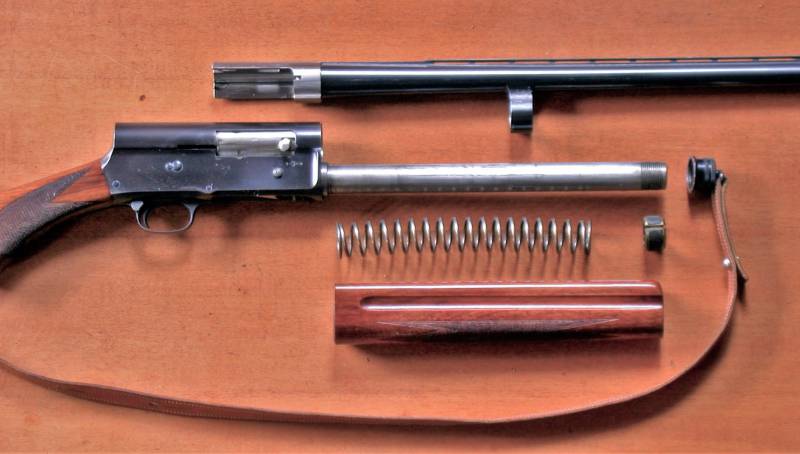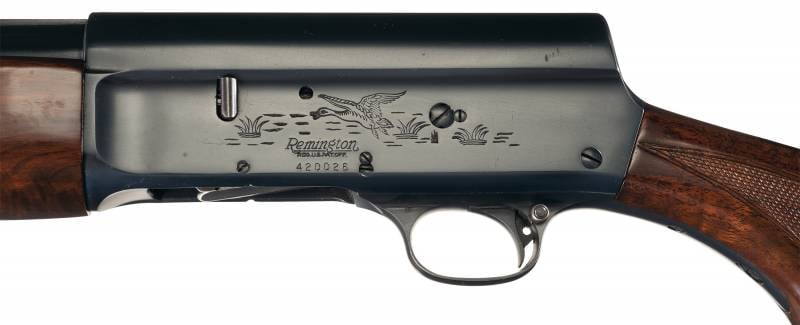Browning Auto-5 self-loading rifle
At the end of the 19th century, armies and amateur shooters mastered new magazine rifles with manual reloading, and automatic systems only took the first steps. However, this did not prevent designers from trying to create systems of completely new classes. In the creation of self-loading smooth-bore guns, J.M. became the pioneer. Browning He created the first version of the project at the very end of the century.
Work on prospective topics began in the 1898 year, and Browning soon prepared design documentation in a new fashion. Soon he collected a prototype gun and tested it in practice. Over the next few years, two more versions of the project appeared, which were also tested using prototype guns. Three variants of the weapon were to use rifle cartridges with smokeless powder and work by rolling back the barrel with a long stroke, however, in the design of these samples were noticeable differences.

General view of the Browning Auto-5 shotgun from the FN company of later release. Photo of Wikimedia Commons
According to the test results of three experienced rifles, the designer stopped at the latest version. It differed from its predecessors in high performance and a more successful design. That it was decided to bring to mass production. After a brief improvement, the project of a self-loading rifle was completed and proposed to a potential manufacturer. In addition, the designer filed a number of applications for the registration of inventions and received four patents.
A little later, after the start of mass production, the new gun received the symbol Browning Auto-5. This title reflected the possibility of automatic reloading, and the figure indicated ready-to-use ammunition in the form of four cartridges in the store and one in the chamber.
A new self-loading rifle was developed using the experience of creating other systems with manual reloading. In particular, the overall layout as a whole was borrowed from other samples. To the front of the receiver was proposed to mount the barrel and the tubular store, which was located on the forearm. Behind the box joined the butt of the required form. Such architecture of the gun, among other things, allowed to carry out a number of upgrades in the future, affecting the ergonomics of the system without significant changes in the internal mechanics.
The main part of the weapon, designed for mounting other mechanisms, was the receiver, made in the form of a unit with a rectangular lower part and a rounded top. From the rear wall of the box departed inclined tube, which served as the casing of the return spring. In the front wall of the box there were openings for mounting the barrel and the magazine, and instead of the bottom it was proposed to mount the frame of the firing mechanism and the magazine inlet. On the right wall of the box was provided a window for ejection of spent cartridges with a small spruce in the back.
The Browning Auto-5 shotgun received a sleek barrel with a length of 711 mm. In the breech of the trunk was attached a special pad to interact with other mechanisms of weapons. In the central part of the trunk there was a ring for contact with the return spring. The cylindrical return spring of the barrel, in turn, had to be put on the body of the store and inside the forearm. Means for additional braking were provided in the barrel rollback system. With the head of the return spring should have been in contact with the ring of variable cross section. The barrel ring, approaching the conical part of the spring ring, was supposed to compress it and increase its adhesion to the magazine body. The change in the design of the braking system made it possible to adapt the self-loading rifle to various ammunition relatively quickly and easily.

Advertising gun "Auto-5" in the Russian catalog, 1910. Photo World.guns.ru
Under the barrel of a new gun J.M. Browning has placed a tubular store of simple design. It had a cylindrical body of the required diameter, on the front of which a thread was provided for the cover. The supply of cartridges was to be carried out using a pusher and a twisted spring placed in front of the store. Equipment shop was made through a window on the bottom of the gun, covered with a spring-loaded lid. On top of the store, a wooden U-shaped forearm was fastened to the rifle. The Browning Auto-5 rifles of some series received a special lever on the left front of the receiver. When turning, he blocked the movement of cartridges from the store to the feeder, which made it possible to quickly change ammunition without full and long store equipment.
The shutter gun was made in the form of a metal block of complex shape. The gate contours were designed so that it could mate tightly with the rear lining of the barrel. Also on the gate means of coupling with the trunk were provided in the form of a set of levers and a swinging larva. Inside the gate there was a cylindrical channel for the striker and the mainspring. With its rear part, the bolt should have been in contact with a return spring placed in a tubular casing. For cocking weapons should use the bolt handle, derived on the right side of the gun.
Shotgun Auto-5 got a trigger type trigger. All the main units of this device were located in the rear lower part of the receiver. The design of the trigger ensured the coaching of the course with its subsequent descent by means of a hook, which was removed on the lower part of the weapon. In the back of the trigger guard was placed a movable fuse button. With its help, it was possible to block the movement of parts USM and thereby prevent unwanted shot.
The first project of J.M. Browning provided for equipping the gun with wooden fittings. Applied handguard, fixed under the barrel and the store, as well as the butt with a pistol protrusion. In the neck of the butt it was proposed to make a channel of small diameter, which goes deep into the part. It should have been located casing return spring bolt.
The basic version of the gun "Auto-5" received a barrel 12-caliber (18,5 mm) and could use the appropriate cartridges for smooth-bore systems. Later versions of weapons were created, calculated for other ammunition. Guns equipped with 16- and 20-caliber barrels were produced. The possibility of creating such modifications was due to successful automation, which could be adapted to use different cartridges with different characteristics.
The gun received the most simple sights in the form of an open mechanical sight, placed above the front of the receiver, and the front sight over the muzzle of the barrel.
With a barrel length of 711 mm, the rifle of the base modification had a full length of 1270 mm and weighed 4,1 kg. In the future, reworking and reworking of various units has repeatedly led to changes in size and weight. Some modifications were shorter and lighter than the base rifle, others were larger and heavier.
The principles of operation of the automation of a new self-loading rifle were fairly simple. At the same time, the project Browning Auto-5 was a real breakthrough in the development and construction of small arms. The ideas laid down in it were later repeatedly used to create new rifles, both modifications of the “Auto-5” and independent developments.

Shotgun L23A1, used by the British army. Photo World.guns.ru
Preparing a gun for shooting was quite simple. Equipment shop was made using a window with a spring-loaded cover on the bottom surface of the receiver. Four rounds should be loaded into the magazine in succession (in the basic configuration of the 12 caliber). After that, the mechanisms were cocked by moving the bolt handle back and returning. Turning off the fuse, you can start shooting.
Pressing the trigger triggered the trigger, which hit the drummer and fired. Under the effect of recoil, the barrel coupled to the bolt had to move backward, compressing both return springs. Due to the specific design of the barrel rollback system, some absorption of the recoil impulse was made with a reduction in the speed of movement of the aggregates. After passing the distance equal to the length of the cartridge case, the automatics uncoupled the bolt and barrel, after which the latter could return to the most forward position.
During the forward movement of the barrel, the spent cartridge case was removed from the chamber. After complete extraction, the sleeve was thrown through a window in the wall of the box. At the same time, the hammer was cocked and the drummer was moved to the neutral position. Then, the spring-loaded feeder had to push the new cartridge from the magazine to the discharging line. Under the action of its own return spring, the bolt had to go forward, push the cartridge into the chamber and re-engage the barrel. After that, the gun was ready for a new shot.

The gun on the machine, designed for training shooters. Photo World.guns.ru
Initially, J.M. Browning had planned that the auto-5 prospective self-loading rifle would be produced by Winchester, which had already produced many designs for it. Nevertheless, the head of the company T.J. Bennett refused to enter into a contract for the release of a gun. Such a decision had two prerequisites of a marketing and economic nature. The Winchester leadership doubted the prospects for a new weapon. Also for the first time in stories the teamwork designer refused to simply sell the project and requested a percentage of sales of serial guns. All this did not suit the leaders of the arms firm, which led to the termination of cooperation with J.M. Browning
Further, the designer offered his development to Remington, however, this time the contract was not concluded. The appearance of the contract was prevented by the unexpected death of the head of the company and the subsequent change of leadership. J.M. Browning again had to look for a potential manufacturer of the world's first self-loading rifles.
In 1902, the gunsmith offered a new system to the Belgian company Fabrique Nationale, which already produced its pistols. Belgian merchants became interested in the proposal, which resulted in the appearance of a new contract and the further development of mass production. At the same time, a curious story occurred that showed the fallacy of T.J.’s judgments. Bennett For his own money J.M. Browning ordered a batch of 10 thousand new guns, which are sent to the United States. In about a year, all the guns were sold out, which showed real prospects for self-loading weapons. Sales in Europe also revealed a major interest from the shooters.
In 1906, official Washington raised import duties on small arms, which had a significant impact on the market. Not wanting to lose a profitable business, J.M. Browning and the company Fabrique Nationale decided to sell the license for the production of rifles Auto-5 American company Remington. Shortly thereafter, new shotguns called the Browning Model 11 appeared on the United States market. About the basic system they were distinguished by some minor details. In particular, the American-made rifles were not equipped with an ammunition blocking system.
The main operators of the new guns are hunters and arrows-athletes. The ability to produce multiple shots without the need for constant manual reloading has become a noticeable advantage over other guns of the same class. Such advantages are often the decisive factor in the purchase, able to level a noticeable difference in price.
In addition, self-loading rifles attracted the attention of several armies. For example, in the interwar period a significant number of Belgian-made Avto-5 guns were purchased by the British Army. After analyzing the experience of the First World War, in which "trenching brooms" were used by some armies, the British military decided to reinforce infantry units with self-loading rifles. In the British army, Browning Auto-5 shotguns received the designation L23A1. During World War II, this weapon was actively used in various operations, primarily in the fight against Japanese troops in Southeast Asia. Guns remained in service after the Second World War.

Scheme gun Remington Mod.11. Figure Okiegunsmithshop.com
An interesting way to use guns J.M. Browning used in military aviation USA. Shotguns were mounted on special machines that simulated machine-gun mounts of bombers, which allowed for the initial training of shooters. This approach made it possible to work out the aiming of weapons with significant savings in ammunition. A number of Auto-5 rifles have also been used in infantry for a long time.
From time to time, both manufacturers carried out modernization of a self-loading rifle in order to improve performance, simplify operation, reduce the cost of production, etc. In addition, the variants "Auto-5", designed for new cartridges of other calibers, were created. Like the base system, new modifications attracted the attention of customers and were sold in large quantities.
According to reports, the Browning Auto-5 shotguns were manufactured by Fabrique Nationale and Remington for several decades, almost throughout the 20th century. During this time, it was released more than two million rifles of all options and modifications. Thus, the Belgian gunsmiths, with constant upgrades, produced Browning Auto-5 guns before the 1974 year, after which the production under license was transferred to the Japanese company Miroku. Japanese license guns were produced until the end of the nineties. American production continued until 1967, with the upgraded Model 11-48 rifle, which was distinguished by its lightweight construction and the shape of various parts, launched into the market in the late 1940s.
Already at the very beginning of the last century, shortly after the start of production, J.M. self-loading rifles. Browning caught the attention of potential buyers. In addition, over time, this development has interested other gunsmiths. As a result, several new rifles based on the mechanics of Avto-5, but released by other companies, entered the market. These or other copies or converted versions of the gun J.M. Browning are produced so far and have a certain distribution.
At the end of the XIX century J.M. Browning was able to develop the world's first smooth-bore gun with the possibility of self-reloading. This sample soon became the first representative of its class, delivered to the series and entered the market. Finally, the Browning Auto-5 shotgun holds another record. This weapon was made for almost 100 years without significant reworking of the structure: all changes concerned only individual parts and did not affect automation. Thus, the designer J.M. Browning was able to create in all senses a unique and outstanding weapon.
On the materials of the sites:
http://world.guns.ru/
http://browning.com/
http://remington.com/
http://stevespages.com/
https://all4shooters.com/
http://militaryfactory.com/





Information